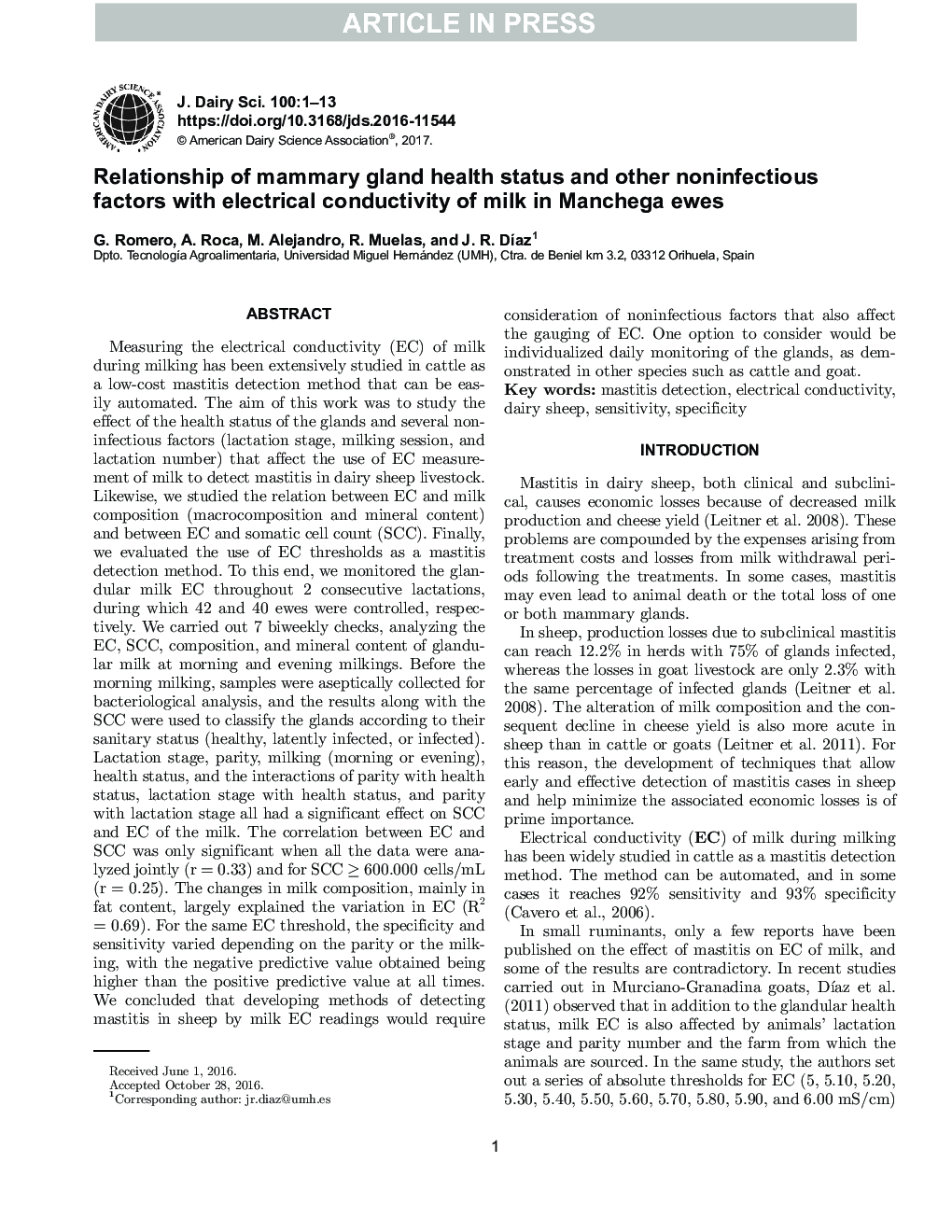| کد مقاله | کد نشریه | سال انتشار | مقاله انگلیسی | نسخه تمام متن |
|---|---|---|---|---|
| 5542460 | 1402518 | 2017 | 13 صفحه PDF | دانلود رایگان |
عنوان انگلیسی مقاله ISI
Relationship of mammary gland health status and other noninfectious factors with electrical conductivity of milk in Manchega ewes
ترجمه فارسی عنوان
رابطه وضعیت سلامت شیر مادر و سایر عوامل غیر عفونی با هدایت الکتریکی شیر در جوجه های مانچگان
دانلود مقاله + سفارش ترجمه
دانلود مقاله ISI انگلیسی
رایگان برای ایرانیان
کلمات کلیدی
تشخیص ماسفتی، رسانایی الکتریکی، گوسفند لبنی حساسیت، اختصاصی،
موضوعات مرتبط
علوم زیستی و بیوفناوری
علوم کشاورزی و بیولوژیک
علوم دامی و جانورشناسی
چکیده انگلیسی
Measuring the electrical conductivity (EC) of milk during milking has been extensively studied in cattle as a low-cost mastitis detection method that can be easily automated. The aim of this work was to study the effect of the health status of the glands and several noninfectious factors (lactation stage, milking session, and lactation number) that affect the use of EC measurement of milk to detect mastitis in dairy sheep livestock. Likewise, we studied the relation between EC and milk composition (macrocomposition and mineral content) and between EC and somatic cell count (SCC). Finally, we evaluated the use of EC thresholds as a mastitis detection method. To this end, we monitored the glandular milk EC throughout 2 consecutive lactations, during which 42 and 40 ewes were controlled, respectively. We carried out 7 biweekly checks, analyzing the EC, SCC, composition, and mineral content of glandular milk at morning and evening milkings. Before the morning milking, samples were aseptically collected for bacteriological analysis, and the results along with the SCC were used to classify the glands according to their sanitary status (healthy, latently infected, or infected). Lactation stage, parity, milking (morning or evening), health status, and the interactions of parity with health status, lactation stage with health status, and parity with lactation stage all had a significant effect on SCC and EC of the milk. The correlation between EC and SCC was only significant when all the data were analyzed jointly (r = 0.33) and for SCC ⥠600.000 cells/mL (r = 0.25). The changes in milk composition, mainly in fat content, largely explained the variation in EC (R2 = 0.69). For the same EC threshold, the specificity and sensitivity varied depending on the parity or the milking, with the negative predictive value obtained being higher than the positive predictive value at all times. We concluded that developing methods of detecting mastitis in sheep by milk EC readings would require consideration of noninfectious factors that also affect the gauging of EC. One option to consider would be individualized daily monitoring of the glands, as demonstrated in other species such as cattle and goat.
ناشر
Database: Elsevier - ScienceDirect (ساینس دایرکت)
Journal: Journal of Dairy Science - Volume 100, Issue 2, February 2017, Pages 1555-1567
Journal: Journal of Dairy Science - Volume 100, Issue 2, February 2017, Pages 1555-1567
نویسندگان
G. Romero, A. Roca, M. Alejandro, R. Muelas, J.R. DÃaz,
